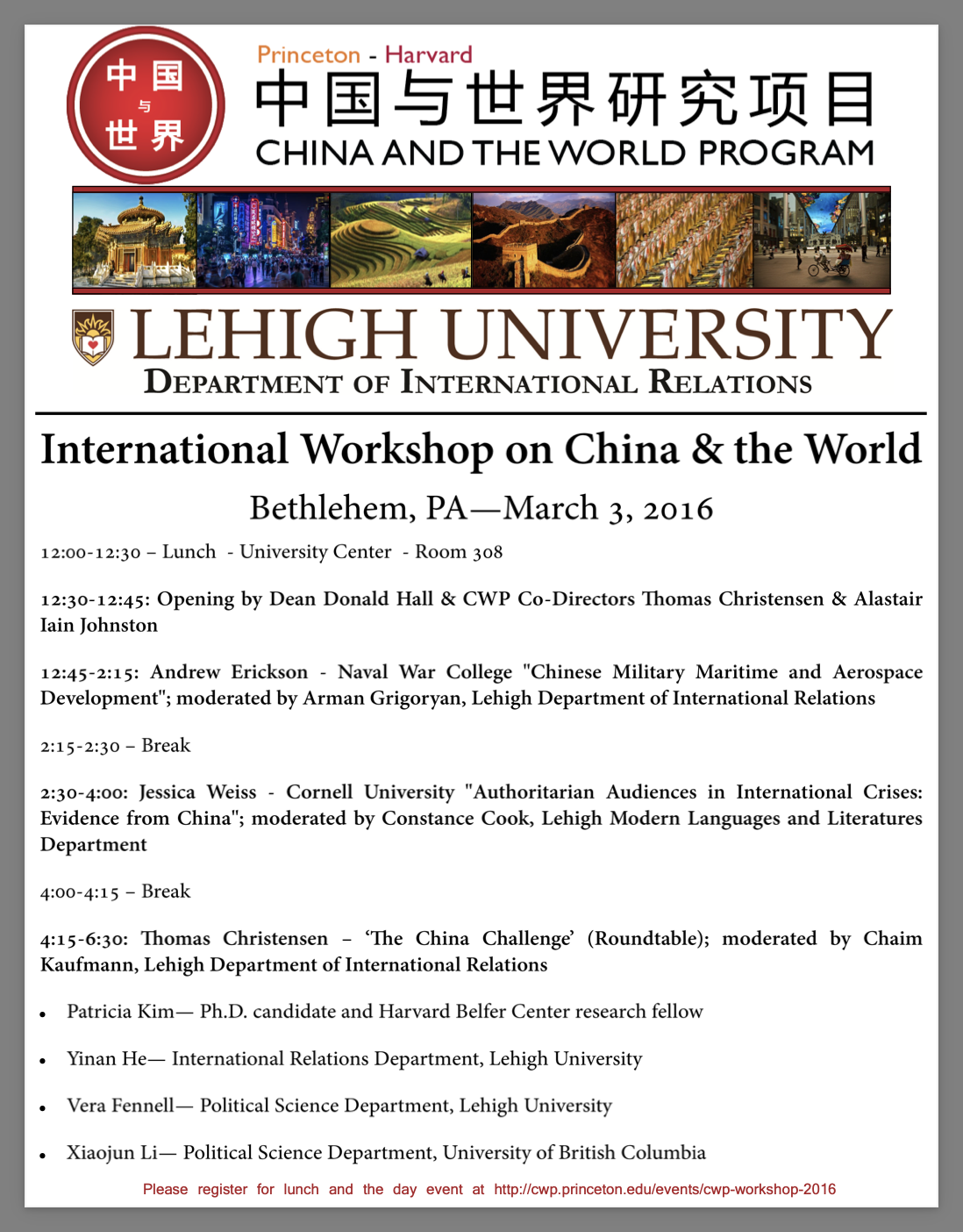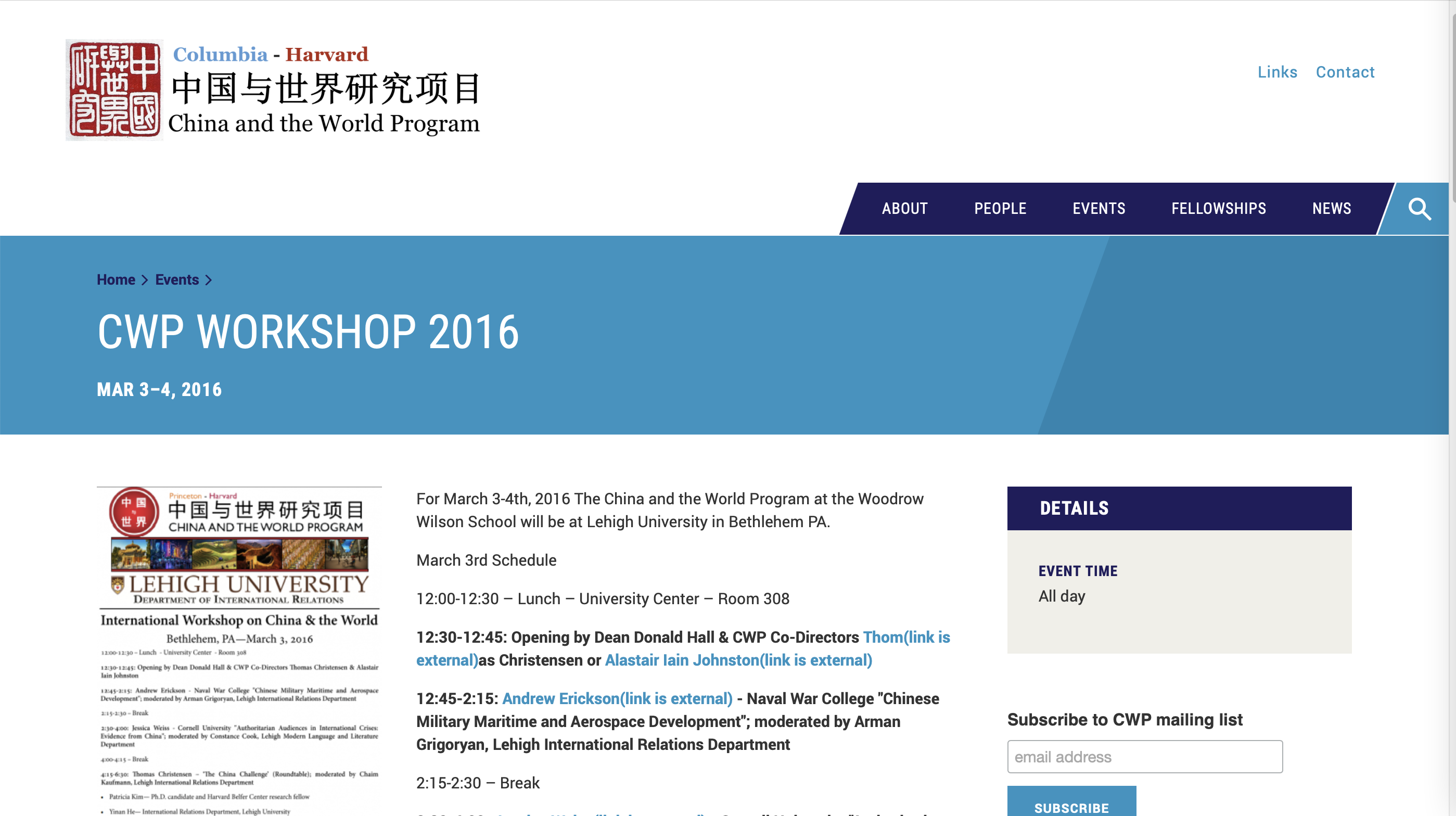Princeton-Harvard China and the World Program: Lectures & Workshop—3-4 March 2016
Andrew S. Erickson, “Chinese Military Maritime and Aerospace Development,” presented at Princeton-Harvard China and the World Program International Workshop, Lehigh University, Lehigh, PA, 3 March 2016.
Princeton-Harvard China and the World Program: Lectures & Workshop—3-4 March 2016
March 3, 2016 – 8:50am to March 4, 2016 – 8:50pm
For March 3-4th, 2016 The China and the World Program at the Woodrow Wilson School will be at Lehigh University in Bethlehem PA.
March 3rd Schedule
12:00-12:30 – Lunch – University Center – Room 308
12:30-12:45: Opening by Dean Donald Hall & CWP Co-Directors
Thomas Christensen or Alastair Iain Johnston
12:45-2:15: Andrew Erickson
– Naval War College “Chinese Military Maritime and Aerospace Development”; moderated by Arman Grigoryan, Lehigh International Relations Department
2:15-2:30 – Break
2:30-4:00: Jessica Weiss
– Cornell University “Authoritarian Audiences in International Crises: Evidence from China”; moderated by Constance Cook, Lehigh Modern Languages and Literatures Department
4:00-4:15 – Break
4:15-6:30: Thomas Christensen – ‘The China Challenge’ (Roundtable); moderated by Professor Chaim Kaufmann, Lehigh International Relations Department
- Patricia Kim Ph.D. candidate and Harvard Belfer Center research fellow
- Yinan He International Relations Department, Lehigh University
- Vera Fennell Political Science Department, Lehigh University
- Xiaojun Li Political Science Department, University of British Columbia
7:00-10:00 CWP Workshop Dinner
March 4th Schedule:
Format for the invitation only-fellows’ workshop:
Dalton Lin:
Title: Great Power Rivalries, Alignment Predispositions, and Patronage Politics on China’s Periphery
Abstract: When competing with other major countries for buying regional influence, what drives a regional power to patronize one neighbor while snubbing another? In the face of competing powers’ cajoling, neighboring countries have both balancing and bandwagonging incentives: their geography, history, and ideology predispose them toward various levels of alignment between competing powers, but these neighbors’ willingness to compromise their alignment predispositions for patronage benefits gives rise to patronage politics on a regional power’s periphery. High security pressures amid zero-sum power rivalries force a regional power to concentrate on consolidating bonds with sympathizers, whose allegiance it must keep to survive the power struggle. In contrast, low security pressures amid loose power rivalries enable the regional power to take a long-term perspective and adventure to court neutral neighbors, who sit on the fence but are responsive to patronizing attempts. This logic helps explain the tradeoffs a regional power makes between cementing its extant sphere of influence and expanding its geopolitical rank and file. A comparative historical analysis of China’s aid to North Vietnam at three critical junctures of the Vietnam War shows how China’s rivalries with the United States and the Soviet Union and its perceptions of North Vietnam’s alignment predispositions affected Beijing’s patronage distribution to Hanoi.
Christina Lai:
Title: Anticipating Rhetorical Traps: China’s Assurance Strategy toward Japan, Malaysia, and the Philippines
Abstract: Beijing’s rhetoric of peaceful rise indeed helped forestall strategic encirclement up until 2010, but China’s turn toward harsher rhetoric and more assertive behavior in 2010 began to create the very counter-balancing coalition that China has sought to prevent. My work examines China’s assurance and reassurance strategy toward Malaysia, the Philippines, and Japan from 1990 to 2010. More specifically, China deploys different foreign discourses toward these three countries to address their concerns, and these countries also positively respond to Chinese rhetoric. However, when China was more assertive from 2010-2013, these three countries applied rhetorical strategies to constrain China’s foreign behavior. They set up different traps to gauge China’s intentions and highlight the inconsistence between China’s previous commitment on peaceful rise and recent assertiveness. My study point outs the “assurance and entrapment” strategy that China and its neighbors deployed toward each other.
Chi-Hung Wei:
Title: A Constructivist Theory of Engagement: U.S. Economic Statecraft toward China after Tiananmen
Abstract: IR scholars have proposed theories of trade with allies and enemies. In the case of U.S.-China relations, because China is neither an American ally nor an American enemy, some scholars have explained U.S. economic engagement with China since the mid-1990s by labeling China a limited-aims revisionist state. However, it is tautological to view the target of engagement as limited-aims revisionist because the sender state engages the target. Building on the constructivist argument that amity and enmity are what states make of them, I argue that China as a limited-aims revisionist state is an effect, rather than a cause, of U.S. engagement. If the United States contains China, China would become an enemy. If Washington engages China, China’s aims would likely remain limited, or China would likely become a status quo power someday under engagement. China will be what Washington makes of it.
If interested in attending on March 3rd, please register here.
Location:
Lehigh University
Audience:
Open to the Public







































